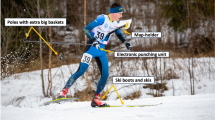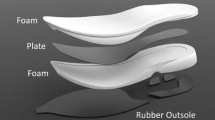Abstract
Helmet manufacturers recommend replacing a bicycle helmet after an impact or after anywhere from 2 to 10 years of use. The goal of this study was to quantify the effect of helmet age on peak headform acceleration during impact attenuation testing of field-used bicycle helmets. Helmets were acquired by donation from consumers and retail stores, and were included in the study if they were free of impact-related damage, had a legible manufacture date label, and were certified to at least one helmet standard. Helmets (n = 770) spanning 0–26 years old were drop tested to measure peak linear headform acceleration during impacts to the right and left front regions of the helmets at two impact speeds (3.0 and 6.2 m/s). General linear mixed models were used to assess the effect of age and three covariates (helmet style, size and certification impact speed) on peak acceleration. Overall, age was related to either no difference or a statistically significant but small increase (≤0.76 g/year of helmet age) in peak headform acceleration. Extrapolated across 20 years, age-related differences were less than both style- (traditional vs. BMX) and size-related differences. The age-related differences were also less than the variability observed between different helmets after accounting for style, size and certification effects. These findings mean that bicycle helmets (up to 26-year-old traditional helmets and 13-year-old BMX helmets) do not lose their ability to attenuate impacts with age; however, other helmet features that may change with age were not evaluated in this study.






Similar content being viewed by others
References
American National Standards Institute. American national standard for protective headgear for bicyclists. ANSI Z90.4. Washington, DC, 1984.
American Society for Testing and Materials International. Standard Specification for Helmets Used in Recreational Roller Skating, F 1751-00. West Conshohocken, PA, 2000.
American Society for Testing and Materials International. Standard Specifications for Helmets Used in Skateboarding and Trick Roller Skating, F 1492-00. West Conshohocken, PA, 2000.
American Society for Testing and Materials International. Standard Specification for Helmets Used in Recreational Bicycling or Roller Skating, F 1447-06. West Conshohocken, PA, 2006.
American Society for Testing and Materials International. Standard Specification for Helmets Used for Recreational Snow Sports, F 2040-06. West Conshohocken, PA, 2006.
American Society for Testing and Materials International. Standard Specification for Helmets Used for Downhill Mountain Bicycle Racing, F 1952-09. West Conshohocken, PA, 2009.
Australian/New Zealand Standard®. Pedal cycle helmets. AS/NZS 2063:1996. Homebush NSW Australia, Wellington New Zealand, 1996.
Cameron, M. H., C. F. Finch, and A. P. Vulcan. The protective performance of bicycle helmets introduced at the same time as the bicycle helmet wearing law in Victoria. Monash University Accident Research Centre Report No. 59, 1994.
Ching, R. P., D. C. Thompson, R. S. Thompson, D. J. Thomas, W. C. Chilcott, and F. P. Rivara. Damage to bicycle helmets involved with crashes. Accid. Anal. Prev. 29(5):555–562, 1997.
Canadian Standards Association. National standard of Canada—cycling helmets, CAN/CSA-D113.2-M89. Toronto, ON, 1989.
Consumer Product Safety Commission. Safety Standard for Bicycle Helmets; Final Rule. 16 CFR Part 1203. Consumer Product Safety Commission, Bethesda, Maryland, 1998.
Consumer Reports, 2012. Best bike helmets www.consumerreports.org. Yonkers, N.Y.
DeMarco, A. L., D. D. Chimich, J. C. Gardiner, and G. P. Siegmund. The impact response of traditional and BMX-style bicycle helmets at different impact severities. Accid. Anal. Prev. 92:175–183, 2016.
European Committee for Standardization, 1997. Helmets for pedal cyclists and for users of skateboards and roller skates, EN 1078. Brussels.
European Committee for Standardization, 2007. Helmets for alpine skiers and snowboarders, EN 1077. Brussels.
Fahlstedt M., K. Baeck, P. Halldin, J. Vander Sloten, J. Goffin, B. Depreitere, and S. Kleiven. Influence of impact velocity and angle in a detailed reconstruction of a bicycle accident. In: Proceedings of the International IRCOBI Conference on the Biomechanics of Impact, IRCOBI Secretariat, Dublin, Ireland, 2012, pp. 787–799.
Kroeker, S. G., S. J. Bonin, A. L. DeMarco, C. A. Good, and G. P. Siegmund. Age does not affect the material properties of expanded polystyrene liners in field-used bicycle helmets. J. Biomech. Eng. 138:041005, 2016.
McIntosh, A. S., and B. Dowdell. A field and laboratory study of the performance of pedal cycle helmets in real accidents. In: Proceedings of the International IRCOBI Conference on the Biomechanics of Impact, IRCOBI Secretariat, Zurich, Switzerland, 1992, pp. 51–72.
McIntosh, A. S., D. Kallieris, R. Mattern, N. L. Svensson, and B. Dowdell. An evaluation of pedal cycle helmet performance requirements (952713). In: Proceedings of 39th Stapp Car Crash Conference, Society of Automotive Engineers, Warrendale, PA, 1995, pp. 111–119.
Smith, T. A., D. Tees, D. R. Thom, and H. H. Hurt Jr. Evaluation and replication of impact damage to bicycle helmets. In: Proceedings of 37th Annual AAAM Conference, San Antonio, TX, 1993, pp. 143–155.
Snell Memorial Foundation. Standard for Protective Headgear for Use in Bicycling. North Highlands, CA: Snell Memorial Foundation, 1984.
Snell Memorial Foundation. Standard for Protective Headgear for Use in Bicycling, B90. North Highlands, CA: Snell Memorial Foundation, 1990.
Snell Memorial Foundation. 1998 Augmentation to the 1990 Standard for Protective Headgear for Use in Bicycling, B90A. North Highlands, CA: Snell Memorial Foundation, 1998.
Verschueren, P. Biomechanical analysis of head injuries related to bicycle accidents and a new bicycle helmet concept. PhD Thesis, Katholieke Universiteit Leuven, Belgium, 2009.
West, B. T., K. B. Welsh, and A. T. Gałecki. Linear Mixed Models—A Practical Guide Using Statistical Software. Chapman & Hall/CRC, Taylor & Francis Group, Boca Raton, FL, 2007.
Williams, M. The protective performance of bicyclists’ helmets in accidents. Accid. Anal. Prev. 23:119–131, 1991.
Acknowledgments
The authors thank Justin Lam, Jeff Nickel and Mircea Oala-Florescu for their help in conducting the tests. We also thank the organizations, companies, and individuals who donated their helmets.
Conflict of interest
Authors ALD, CAG, DDC and GPS are forensic consultants who occasionally work on cases related to bicycle helmet effectiveness. No external funding was received for this study: all funding and support was provided by MEA Forensic Engineers & Scientists (employer of ALD, DDC, GPS) and Collision Analysis (employer of CAG). DDC and GPS are shareholders of MEA Forensic and CAG owns Collision Analysis.
Author information
Authors and Affiliations
Corresponding author
Additional information
Associate Editor Karol Miller oversaw the review of this article.
Appendices
Appendix A: Manufacturer’s Helmet Replacement Recommendations
See Table A1.
Appendix B: Summary of Helmet Data
Rights and permissions
About this article
Cite this article
DeMarco, A.L., Good, C.A., Chimich, D.D. et al. Age has a Minimal Effect on the Impact Performance of Field-Used Bicycle Helmets. Ann Biomed Eng 45, 1974–1984 (2017). https://doi.org/10.1007/s10439-017-1842-4
Received:
Accepted:
Published:
Issue Date:
DOI: https://doi.org/10.1007/s10439-017-1842-4




